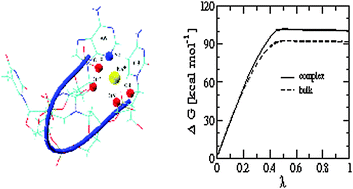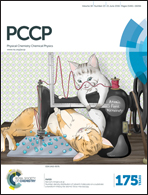Exploring ion induced folding of a single-stranded DNA oligomer from molecular simulation studies†
Abstract
One crucial issue in DNA hydration is the effect of salts on its conformational features. This has relevance in biology as cations present in the cellular environment shield the negative charges on the DNA backbone, thereby reducing the repulsive force between them. By screening the negative charges along the backbone, cations stabilize the folded structure of DNA. To study the effect of the added salt on single-stranded DNA (ss-DNA) conformations, we have performed room temperature molecular dynamics simulations of an aqueous solution containing the ss-DNA dodecamer with the 5′-CGCGAATTCGCG-3′ sequence in the presence of 0.2, 0.5, and 0.8 M NaCl. Our calculations reveal that in the presence of the salt, the DNA molecule forms more collapsed coil-like conformations due to the screening of negative charges along the backbone. Additionally, we demonstrated that the formation of an octahedral inner-sphere complex by the strongly bound ion plays an important role in the stabilization of such folded conformation of DNA. Importantly, it is found that ion–DNA interactions can also explain the formation of non-sequential base stackings with longer lifetimes. Such non-sequential base stackings further stabilize the collapsed coil-like folded form of the DNA oligomer.


 Please wait while we load your content...
Please wait while we load your content...